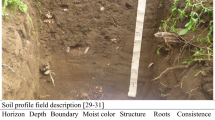Summary
Three different types of organic materialsviz berseem hay, farm yard manure and wheat straw at two different rates were applied to an alluvial sandy loam soil and incubated at 30 MoC to investigate their rate of decomposition as well as their effect on the development of soil microflorai.e. bacteria, actinomycetes, fungi and Azotobacter.
Berseem hay decomposed rapidly in the initial stages but after 30 days wheat straw + N and wheat straw alone released more CO2. FYM showed an uniform and steady rate of decomposition.
Microbiological changes showed a fluctuating trend. In general, maximum increase in bacterial, actinomycete and fungi population was observed at 30 and 90 days period, followed by the lowest activity at 60 and 120 days. However, again an increasing trend was observed after 120 days of incubation period. Berseem hay showed the highest zymogenic effect in the initial stages. FYM had marked influence on the fungal population while wheat straw with and without nitrogen showed a decreasing trend. Azotobacter population was appreciably increased by the addition of wheat straw alone. Other treatments including wheat straw + N recorded a slight effect.
Chemical analysis at the end of the experimental period indicated favourable effect of organic materials on humic acid content, organic carbon, total nitrogen and available nutrientsviz nitrogen, phosphorus, and sulphur. FYM increased organic carbon by 77% over control followed by wheat straw 75%. This suggests that the addition of FYM and crop residues has a positive effect on the maintenance of organic matter in the soil.
The effect of different levels of organic materials showed only quantitative difference. In general, no marked variations were observed on the pattern of CO2 evolution, microbiological and chemical changes.
Similar content being viewed by others
References
Acharya, C. N. and Rajagopalan, K., Effect of continuous application of manures and fertilizers on carbon and nitrogen levels of the soil. J. Indian Soc. Soil Sci.4, 111–123 (1956).
Alexander, M., Introduction to Soil Microbiology. John Wiley and Sons, New York (1961).
Allen, O. N., Experiments in Soil Bacteriology. Burgess publishing Co., Minneapolis 15, Minnesota (1957).
Bear, F. E., Some soil organic matter relationships. Trans. 4th Internal. Congr. Soil Amsterdam,1, 114–125 (1950).
Bhardwaj, K. K. R. and Gaur, A. C., The effect of humic and fulvic acid on growth and efficiency of nitrogen fixation byAzotobacter chroococcum. Folia Microbiol.15, 364–367 (1970).
Birch, H. F., The effect of soil drying on humus decomposition and nitrogen availability. Plant and Soil10, 9–31 (1958).
Chaminade, R., A method of determination of humus in soils. Ann. Agron.16, 117–132 (1946).
Chesmin, L. and Yien, C. H., Turbidimetric determination of available sulphate. Soil Sci. Soc. Am. Proc.15, 149 (1957).
Dickman, S. R. and Bray, R. H., Colorimetric determination of phosphorus. Ind. Eng. Chem. Anal.12, 665–668 (1940).
Frederick, L. R. and Rothwell, D. F., The decomposition of alfalfa and corn stover in soil: microbial population at various temperatures. Bact. Proc.57, 10 (1957).
Gaur, A. C., Mathur, R. S. and Kavimandan, S. K., In vitro nitrogen fixation byAzotobacter as influenced by plant materials and their extracts. Agrochimica13, 81–84 (1968–69).
Gray, P. H. H. and Wallace, R. H., Correlation between bacterial numbers and CO2 in a field soil. Can. J. Microbiol.3, 191–194 (1967).
Jackson, M. L., Soil Chemical Analysis. Constable & Co. Ltd., London, (1958).
Jenny, H. and Raychaudhri, S. P., Effect of climate and cultivation on nitrogen and organic matter reserves in Indian soils. Indian Council of Agricultural Research, New Delhi (1967).
Jensen, H. L., Contributions to the microbiology of Australian soils. IV. The activity of microorganisms in the decomposition of organic matter. Proc. Linn. Soc. New South Wales61, 27–55 (1936).
Keen, B. A., The Agricultural Development of Middle East. Appendix I. Note on the addition of organic matter to tropical soils. H. M. Stationary Office, London (1946).
Khandelwal, K. C. and Gaur, A. C., Microbial decomposition of humic acid in soil. Ind. J. Microbial.9, 87–92 (1969).
Khandelwal, K. C. and Gaur, A. C., Influence of humate on the growth of moong (Phaseolus aureus). Sci. and Cult.36, 110–111 (1970).
Lenz, K., Decomposition of organic substances of different N contents. Albrecht Thaer Arch.12, 413–423 (1968).
Melin, S., Biological decomposition of some types of litter from North American forests. Ecology11, 72–101 (1930).
Olsen, S. R., Estimation of available phosphorus by extraction with sodium bicarbonate. U.S.D.A. Circ. No.939 (1954).
Pramer, D. and Schmidt, E. L., Experimental Soil Microbiology. Burgess Publishing Co., Minneapolis 15, Minnesota (1964).
Romell, L. G., Ecological problems of the humus layer in the forest. Cornell Univ. Agr. Exp. Sta. Mem.170 (1935).
Russell, E. W., The role of organic matter in soil productivity. The use of Isotopes in soil organic matter studies, Rept. FAO/IAEA. Tech. Meeting Brunswick Volkenrode 3–19 (1963).
Sivaraman, M. S., Green manuring some mistaken notions. Radioisotopes, fertilizer and cowdung gas plant. Proc. Symp. World Agr. Fair, New Delhi (1960).
Smith, F. B., Brown, P. E. and Millar, R. C., The rhythmical nature of microbiological activity in soil as indicated by the evolution of carbon dioxide. J. Amer. Soc. Agron.27, 104–108 (1935).
Subbiah, B. V. and Asija, G. L., A rapid procedure of determination of available nitrogen in soil. Current Sci.25, 259–260 (1956).
Todorova, B., Decomposition of certain organic materials in alluvial meadow and leached chernozems forests. Poch. Agrokhim.2, 94–104 (1967).
Vandecaveye, S. C., Microbial activity in relation to organic matter transformations in soil. Trans. 3rd Comm. Intern. Soc. Soil Sci. (A), 120–129 (1939).
Vandecaveye, S. C. and Baker, G. O., Activity of specific groups of microbes in different soils. Soil Sci.45, 315–333 (1938).
Waksman, S. A. and Starkey, R. L., The Soil and the Microbe. John Wiley & Sons, Inc. New York (1931).
Whitehead, D. C., Some aspects of the influence of organic matter on soil fertility. Soils & Fert.26, 217–223 (1963).
Author information
Authors and Affiliations
Rights and permissions
About this article
Cite this article
Gaur, A.C., Sadasivam, K.V., Vimal, O.P. et al. A study on the decomposition of organic matter in an alluvial soil: CO2 evolution, microbiological and chemical transformations. Plant Soil 35, 17–28 (1971). https://doi.org/10.1007/BF01372628
Received:
Revised:
Issue Date:
DOI: https://doi.org/10.1007/BF01372628




